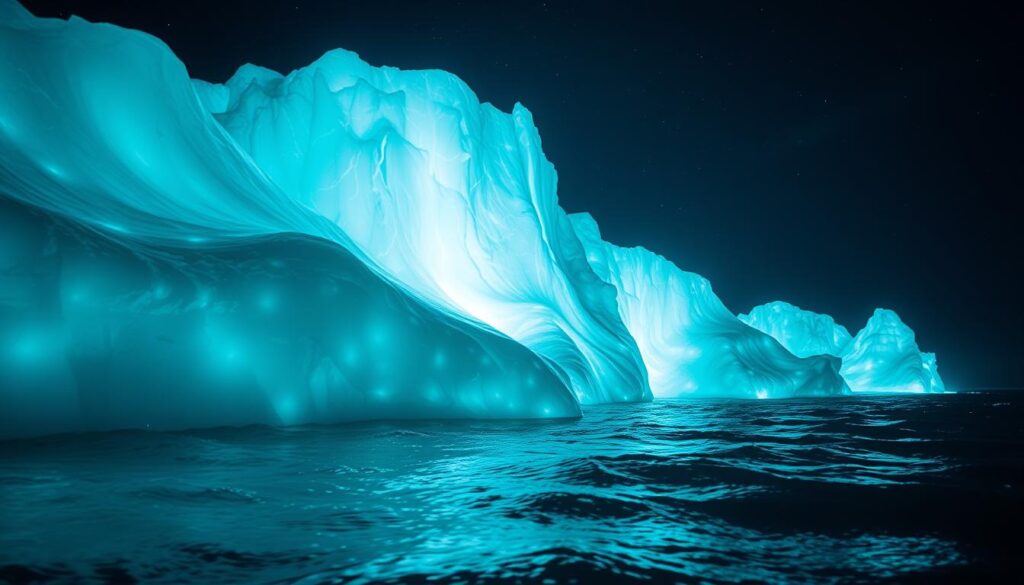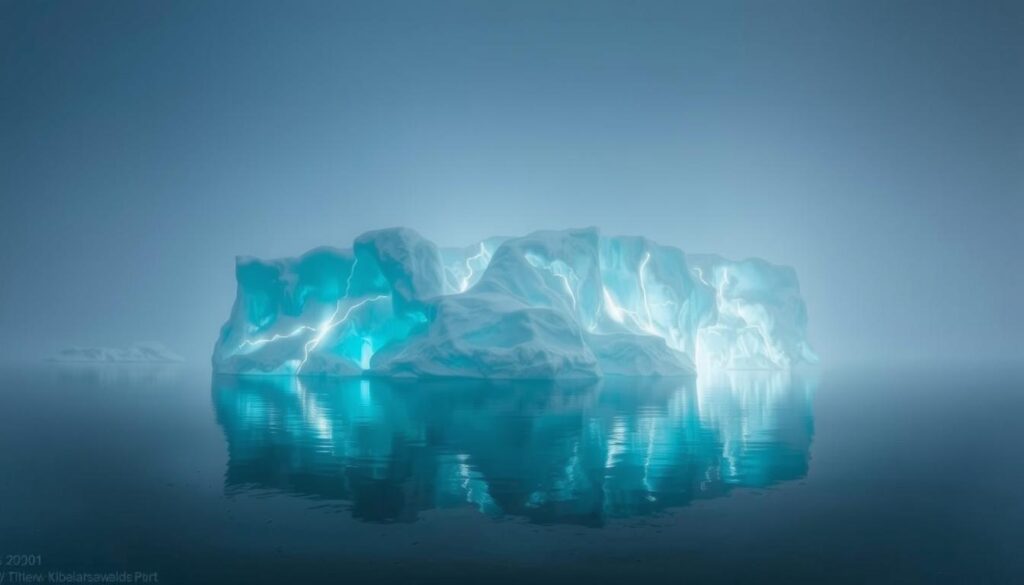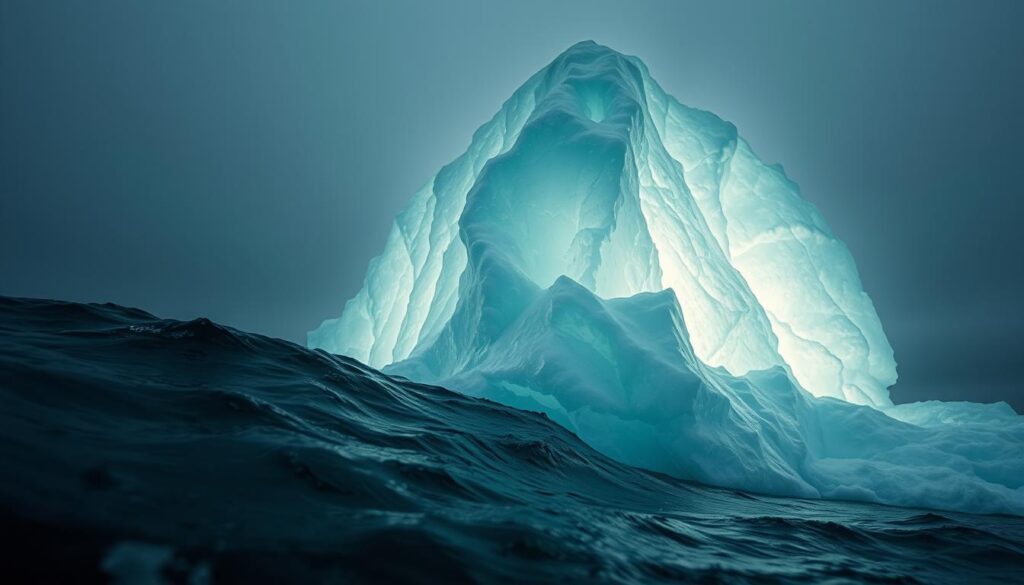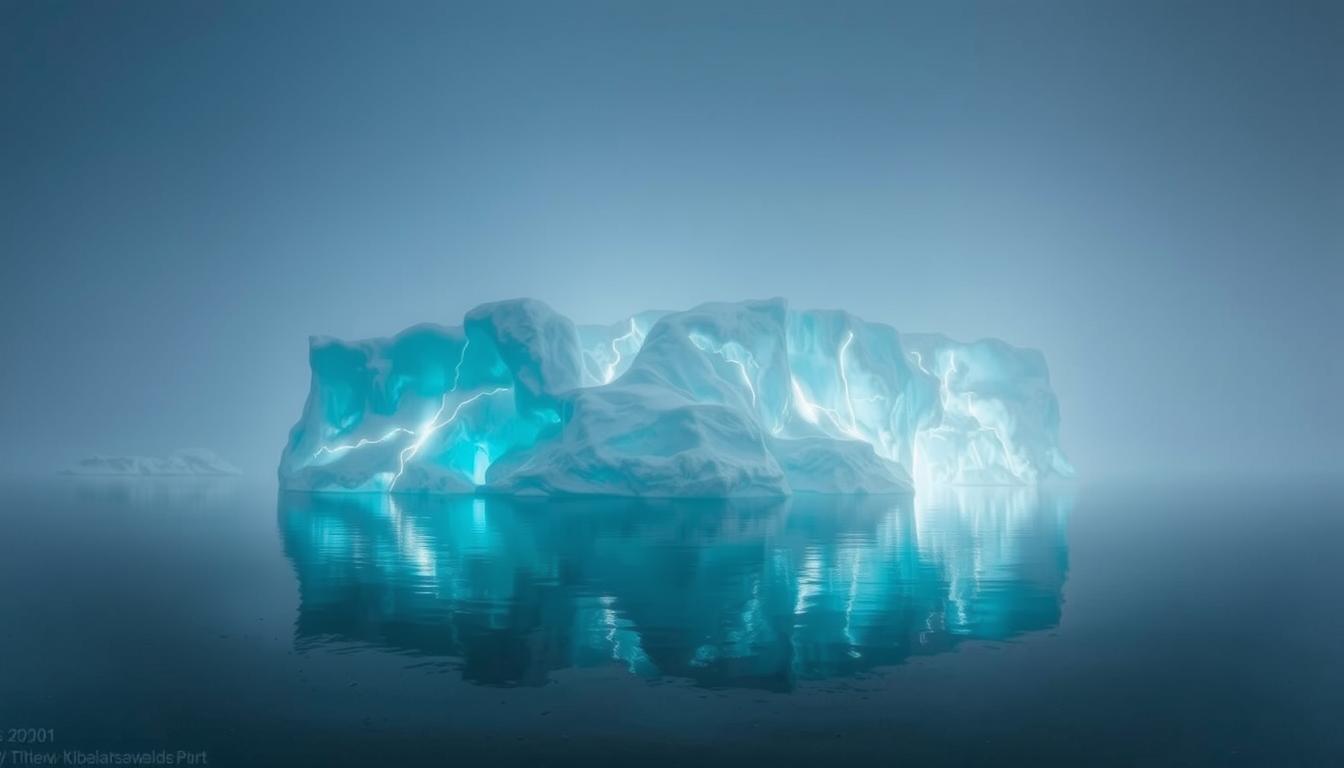The glowing icebergs have caught many people’s attention. Bioluminescence is the main reason behind this amazing sight. These glowing icebergs can be seen in some parts of the world. They exist because of bioluminescence in the water.

We will explore bioluminescence and how it lights up icebergs. This article aims to give you a deep understanding of this topic. We’ll talk about what makes icebergs glow and how climate change affects these wonders. We’ll focus on glowing icebergs and the science of bioluminescence.
Key Takeaways
- Bioluminescence is the key to understanding glowing icebergs
- Glowing icebergs can be found in certain parts of the world
- The presence of bioluminescence in the water is crucial for glowing icebergs to exist
- Climate change has an impact on the existence of glowing icebergs
- Understanding bioluminescence is essential to appreciating the beauty of glowing icebergs
- Glowing icebergs are a rare and fascinating natural phenomenon
The Mysterious Phenomenon of the Glowing Iceberg
The glowing iceberg phenomenon is seen in Arctic waters. Here, cold temperatures and marine life create a perfect setting for bioluminescence. This natural wonder has caught the attention of scientists and the public, who are eager to learn more about it.
Glowing icebergs have been spotted in different parts of the Arctic waters. Their first sightings were in the early 20th century. Since then, they have become a topic of interest for many.
People are amazed and curious about glowing icebergs. Many share their experiences and photos on social media. The factors that make these icebergs glow include:
- Cold temperatures
- Marine life
- Iceberg size and shape
Understanding these factors helps us appreciate the glowing iceberg phenomenon. As we continue to study this natural wonder, we may discover more about the iceberg illumination and its role in the Arctic waters.
When an Iceberg Glows in the Dark: Understanding the Science
The glow of icebergs is a complex process. It involves bioluminescence, ice formation, and ocean currents. To grasp this, we must explore the science behind glowing icebergs. Bioluminescence is key, as it’s the light produced by living things like phytoplankton and bacteria in the icebergs.
Climate change greatly affects glowing icebergs. As the Earth warms, icebergs melt faster. This impacts the bioluminescent life they host. Understanding this helps us protect these wonders. It’s crucial for effective conservation efforts.
- Ocean currents and their role in transporting bioluminescent organisms
- The formation of ice and its impact on the bioluminescent organisms
- The effects of climate change on the distribution and frequency of glowing icebergs
By grasping these factors, we can appreciate the complexity of glowing icebergs. This knowledge helps us manage and conserve these natural wonders. It also aids in fighting climate change on our planet.
The Role of Bioluminescence in Arctic Waters
Bioluminescence is key to glowing icebergs. In Arctic waters, it comes from marine life like plankton, fish, and crustaceans. They use it for talking, finding mates, and defending themselves. Their light together makes glowing icebergs shine.
Marine Organisms That Create Light
Some marine life that adds to Arctic bioluminescence includes:
- Plankton, such as dinoflagellates and copepods
- Fish, such as dragonfish and anglerfish
- Crustaceans, such as krill and shrimp
Seasonal Patterns of Bioluminescent Activity
Bioluminescence in Arctic waters changes with the seasons. It’s most active in summer when the sun shines longer. This is because many glow-makers need sunlight to shine.
Chemical Processes Behind the Glow
The glow from bioluminescence comes from complex chemical reactions. These reactions involve luciferin, a molecule that reacts with oxygen to make light.
Different Types of Iceberg Illumination
Iceberg illumination in Arctic waters is truly breathtaking. It shows the beauty of nature in many ways. The Arctic waters shape how icebergs glow, from soft bioluminescent lights to bright sunlit colors.
The look of glowing icebergs depends on marine life, water temperature, and sunlight. In the Arctic, these elements create a magical scene. The best time to see this is in summer, when the sun is high and the waters are calm.
Some common types of iceberg light include:
- Bioluminescent glow: caused by marine organisms like plankton and algae
- Solar illumination: from sunlight reflecting off the icebergs
- Lunar illumination: from moonlight reflecting off the icebergs

In summary, the variety in iceberg light comes from marine life, sunlight, and temperature. Knowing these factors helps us enjoy the beauty of iceberg light even more.
How Weather Conditions Affect Iceberg Luminescence
Weather conditions greatly impact the look and behavior of glowing icebergs. Temperature is key to understanding how marine life glows. When it’s colder, the icebergs glow more, making them stand out.
Impact of Temperature
Changes in temperature affect how marine life glows. In cold waters, the glow is stronger, making icebergs more vibrant. This is because cold slows down the life processes of organisms, leading to a brighter glow. As it gets warmer, the glow fades, making icebergs harder to see.
Light Refraction and Arctic Conditions
Light refraction is vital in how glowing icebergs appear. The Arctic’s unique mix of ice, water, and air is perfect for this. It makes the icebergs’ glow even more stunning. The way light and Arctic conditions work together is key to understanding the glowing icebergs’ beauty.
It’s important to understand how weather affects glowing icebergs for conservation. As climate change impacts the Arctic, watching how icebergs glow changes is crucial. By studying temperature, light refraction, and other weather factors, we can learn more about the icebergs, marine life, and the Arctic ecosystem.
Similar Natural Light Phenomena Around the World
Glowing icebergs are not alone in the world of natural light displays. Many other light shows occur globally. These are often due to bioluminescence, where living things make light. For example, New Zealand’s glowworm caves are filled with thousands of glowworms. They light up the cave ceilings, making it look like a starry night sky.
In Puerto Rico, the bioluminescent bays glow blue when the water is disturbed. The Northern Lights in the Arctic are another wonder. They happen when sun particles meet the Earth’s magnetic field. These sights are not just beautiful but also teach us about bioluminescence and our environment.
Some of the most amazing natural light shows include:
- Glowworm caves of New Zealand
- Bioluminescent bays of Puerto Rico
- Northern Lights of the Arctic
These wonders show us the beauty of nature and why we must protect it. Studying glowing icebergs and other light phenomena helps us understand climate change and our ecosystem’s balance.
Environmental Significance of Glowing Icebergs
Glowing icebergs are a fascinating phenomenon that has caught a lot of attention lately. These icebergs, found in Arctic waters, are not just a natural wonder. They also show how healthy Arctic ecosystems are. The glow comes from bioluminescent organisms that live in the cold Arctic waters.
The presence of glowing icebergs in Arctic waters is very important for the environment. Climate change is changing how icebergs form and melt. This affects the homes of many marine species. The glow can also help scientists understand how climate change impacts Arctic ecosystems.
Some important points about glowing icebergs include:
- Impact of climate change on iceberg formation and melting
- Role of bioluminescent organisms in Arctic ecosystems
- Importance of conservation efforts to protect Arctic habitats
There are many research areas related to glowing icebergs. Scientists can study the bioluminescent organisms and how climate change affects Arctic ecosystems. They also need to focus on protecting Arctic habitats due to conservation concerns.
Photographing and Documenting Luminescent Icebergs
Capturing glowing icebergs is a challenging but rewarding task. You’ll need a high-quality camera and tripod. Knowing the best times to shoot is also key. It’s important to be responsible and sustainable in your photography to protect these wonders.
Photographing these icebergs means thinking about climate change. Rising temperatures and melting ice caps change how icebergs form and behave. By sharing your photos, you can help start conversations about climate change and conservation.

Here are some tips for capturing glowing icebergs: * Use a camera that works well in low light. * Bring a tripod to keep your camera steady. * Be patient and wait for the perfect shot. * Always respect the environment and follow sustainable practices. By following these tips, you can take amazing photos of glowing icebergs while helping to protect them.
Conclusion: The Future of Arctic Light Shows
As we say goodbye to the glowing icebergs, we see their great importance. They fascinate scientists and the public alike. The mix of bioluminescence and Arctic conditions has made us more curious about these ecosystems.
We must learn from glowing icebergs and their link to climate change. Supporting research and conservation is key. This way, we can keep these amazing light shows in the Arctic for future generations. Scientists will keep exploring bioluminescence and its effects on marine life.
The glowing icebergs remind us of nature’s beauty and its vulnerability. They inspire us to protect the Arctic and its wonders. Let’s work together to preserve these “light shows” for everyone to enjoy and appreciate.
FAQ
What causes icebergs to glow?
Icebergs glow due to bioluminescence. This is when living things make and send out light. In Arctic waters, creatures like plankton and fish light up the icebergs.
Where can glowing icebergs be found?
You can find glowing icebergs in the Arctic. The cold and bioluminescent sea life there make it perfect for this sight. People have been talking about glowing icebergs since the early 1900s.
How does climate change impact the frequency and distribution of glowing icebergs?
Climate change affects glowing icebergs a lot. Warmer temperatures and ocean changes mess with the Arctic’s balance. This can make glowing icebergs less common or harder to see.
What are the different types of iceberg illumination?
Icebergs can glow in many ways. They can softly light up with bioluminescence or shine brightly with sunlight. The look of an iceberg’s glow depends on its temperature, the light, and its ice structure.
How can I best photograph and document glowing icebergs?
Taking pictures of glowing icebergs is exciting but tricky. You need the right gear and know when and how to take photos. By doing it right, you can share the beauty of glowing icebergs and help protect them.
